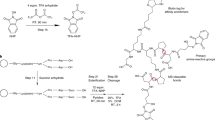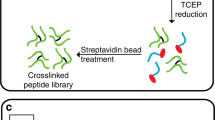Abstract
Cross-linking coupled with mass spectrometry (XL-MS) has emerged as a powerful strategy for the identification of protein–protein interactions, characterization of interaction regions, and obtainment of structural information on proteins and protein complexes. In XL-MS, proteins or complexes are covalently stabilized with cross-linkers and digested, followed by identification of the cross-linked peptides by tandem mass spectrometry (MS/MS). This provides spatial constraints that enable modeling of protein (complex) structures and regions of interaction. However, most XL-MS approaches are not capable of differentiating intramolecular from intermolecular links in multimeric complexes, and therefore they cannot be used to study homodimer interfaces. We have recently developed an approach that overcomes this limitation by stable isotope–labeling of one of the two monomers, thereby creating a homodimer with one 'light' and one 'heavy' monomer. Here, we describe a step-by-step protocol for stable isotope–labeling, followed by controlled denaturation and refolding in the presence of the wild-type protein. The resulting light–heavy dimers are cross-linked, digested, and analyzed by mass spectrometry. We show how to quantitatively analyze the corresponding data with SIM-XL, an XL-MS software with a module tailored toward the MS/MS data from homodimers. In addition, we provide a video tutorial of the data analysis with this protocol. This protocol can be performed in ∼14 d, and requires basic biochemical and mass spectrometry skills.
This is a preview of subscription content, access via your institution
Access options
Access Nature and 54 other Nature Portfolio journals
Get Nature+, our best-value online-access subscription
$29.99 / 30 days
cancel any time
Subscribe to this journal
Receive 12 print issues and online access
$259.00 per year
only $21.58 per issue
Buy this article
- Purchase on Springer Link
- Instant access to full article PDF
Prices may be subject to local taxes which are calculated during checkout





















Similar content being viewed by others
References
Marianayagam, N.J., Sunde, M. & Matthews, J.M. The power of two: protein dimerization in biology. Trends Biochem. Sci. 29, 618–625 (2004).
Brannigan, J.A. et al. A protein catalytic framework with an N-terminal nucleophile is capable of self-activation. Nature 378, 416–419 (1995).
Berman, H.M. et al. The Protein Data Bank. Nucleic Acids Res. 28, 235–242 (2000).
Sinz, A. Chemical cross-linking and mass spectrometry to map three-dimensional protein structures and protein–protein interactions. Mass Spectrom. Rev. 25, 663–682 (2006).
Lima, D.B. et al. SIM-XL: a powerful and user-friendly tool for peptide cross-linking analysis. J. Proteomics 129, 51–55 (2015).
Rappsilber, J. The beginning of a beautiful friendship: cross-linking/mass spectrometry and modelling of proteins and multi-protein complexes. J. Struct. Biol. 173, 530–540 (2011).
Schmidt, C. & Robinson, C.V. A comparative cross-linking strategy to probe conformational changes in protein complexes. Nat. Protoc. 9, 2224–2236 (2014).
Sinz, A., Arlt, C., Chorev, D. & Sharon, M. Chemical cross-linking and native mass spectrometry: a fruitful combination for structural biology. Protein Sci. 24, 1193–1209 (2015).
Jiang, G., den Hertog, J. & Hunter, T. Receptor-like protein tyrosine phosphatase alpha homodimerizes on the cell surface. Mol. Cell. Biol. 20, 5917–5929 (2000).
Vashisth, H. & Abrams, C.F. Docking of insulin to a structurally equilibrated insulin receptor ectodomain. Proteins 78, 1531–1543 (2010).
Walker, R.G. et al. The structure of human apolipoprotein A-IV as revealed by stable isotope-assisted cross-linking, molecular dynamics, and small angle X-ray scattering. J. Biol. Chem. 289, 5596–5608 (2014).
Melchior, J.T. et al. An evaluation of the crystal structure of C-terminal truncated apolipoprotein A-I in solution reveals structural dynamics related to lipid binding. J. Biol. Chem. 291, 5439–5451 (2016).
Iglesias, A.H., Santos, L.F.A. & Gozzo, F.C. Identification of cross-linked peptides by high-resolution precursor ion scan. Anal. Chem. 82, 909–916 (2010).
Leitner, A., Walzthoeni, T. & Aebersold, R. Lysine-specific chemical cross-linking of protein complexes and identification of cross-linking sites using LC-MS/MS and the xQuest/xProphet software pipeline. Nat. Protoc. 9, 120–137 (2014).
Holding, A.N., Lamers, M.H., Stephens, E. & Skehel, J.M. Hekate: software suite for the mass spectrometric analysis and three-dimensional visualization of cross-linked protein samples. J. Proteome Res. 12, 5923–5933 (2013).
Du, X. et al. Xlink-Identifier: an automated data analysis platform for confident identifications of chemically cross-linked peptides using tandem mass spectrometry. J. Proteome Res. 10, 923–931 (2011).
Liu, F., Lössl, P., Scheltema, R., Viner, R. & Heck, A.J.R. Optimized fragmentation schemes and data analysis strategies for proteome-wide cross-link identification. Nat. Commun. 8, 15473 (2017).
Liu, F., Rijkers, D.T.S., Post, H. & Heck, A.J.R. Proteome-wide profiling of protein assemblies by cross-linking mass spectrometry. Nat. Methods 12, 1179–1184 (2015).
Borges, D. et al. Using SIM-XL to identify and annotate cross-linked peptides analyzed by mass spectrometry. Protoc. Exch. http://dx.doi.org/10.1038/protex.2015.015 (2015).
Borges, D. et al. Effectively addressing complex proteomic search spaces with peptide spectrum matching. Bioinforma. Oxf. Engl. 29, 1343–1344 (2013).
Rinner, O. et al. Identification of cross-linked peptides from large sequence databases. Nat. Methods 5, 315–318 (2008).
Bai, X. et al. Nature 525, 212–217 (2015).
Keskin, O., Tuncbag, N. & Gursoy, A. Predicting protein-protein interactions from the molecular to the proteome level. Chem. Rev. 116, 4884–4909 (2016).
Kang, S. et al. Synthesis of biotin-tagged chemical cross-linkers and their applications for mass spectrometry. Rapid Commun. Mass Spectrom. 23, 1719–1726 (2009).
Chambers, M.C. et al. A cross-platform toolkit for mass spectrometry and proteomics. Nat. Biotechnol. 30, 918–920 (2012).
Rosano, G.L. & Ceccarelli, E.A. Recombinant protein expression in Escherichia coli: advances and challenges. Front. Microbiol. 5, 172 (2014).
Becker, G.W. Stable isotopic labeling of proteins for quantitative proteomic applications. Brief. Funct. Genomic Proteomic 7, 371–382 (2008).
Kapust, R.B., Tözsér, J., Copeland, T.D. & Waugh, D.S. The P1' specificity of tobacco etch virus protease. Biochem. Biophys. Res. Commun. 294, 949–955 (2002).
Tubb, M.R., Smith, L.E. & Davidson, W.S. Purification of recombinant apolipoproteins A-I and A-IV and efficient affinity tag cleavage by tobacco etch virus protease. J. Lipid Res. 50, 1497–1504 (2009).
Markwell, M.A.K., Haas, S.M., Bieber, L.L. & Tolbert, N.E. A modification of the Lowry procedure to simplify protein determination in membrane and lipoprotein samples. Anal. Biochem. 87, 206–210 (1978).
Carvalho, P.C. et al. YADA: a tool for taking the most out of high-resolution spectra. Bioinformatics 25, 2734–2736 (2009).
Vizcaíno, J.A. et al. The PRoteomics IDEntifications (PRIDE) database and associated tools: status in 2013. Nucleic Acids Res. 41, D1063–D1069 (2013).
Acknowledgements
V.C.B. acknowledges a FAPERJ BBP grant, as well as support from CNPq and CAPES. P.C.C. acknowledges the Fundação Araucária Universal/Jovem Pesquisador Grant and support from PAPES VII and Universal CNPq. D.B.L. and J.C.-R. acknowledge the Centre National de la Recherche Scientifique (CNRS) for financial support. F.C.G. and M.F. acknowledge support from FAPESP (grants 2014/17264-3 and 2012/10862-7) and CNPq. The mass spectrometry methods were established in the UC Proteomics Laboratory on the Sciex 5600 + TripleTOF system, funded in part through an NIH-shared instrumentation grant (S10 RR027015-01; K.D. Greis, principal investigator). This work was also supported by an American Heart Association postdoctoral fellowship grant (16POST27710016 to J.T.M.) and by funding from the National Institutes of Health Heart, Lung and Blood Institute (R01 GM098458 and P01 HL128203 to W.S.D.).
Author information
Authors and Affiliations
Contributions
D.B.L., P.C.C., F.C.G., and V.C.B. have participated in the development of the SIM-XL project since its beginning in 2015. D.B.L., J.T.M., W.S.D., P.C.C., and F.C.G. participated in developing the SIM-XL module tailored for homodimers. J.T.M., W.S.D., J.C.-R., J.S.G.F., J.M., and T.A.C.B.S. participated in describing the experimental methodology. D.B.L., P.C.C., and V.C.B. participated in writing the data-analysis methodology. M.F. participated in developing the SIM-XL software and in describing the computational methodology. All authors participated in writing the Introduction and Anticipated Results sections. D.B.L., J.C.-R., and P.C.C. created the supplementary video. All authors read and approved the manuscript.
Corresponding authors
Ethics declarations
Competing interests
The authors declare no competing financial interests.
Integrated supplementary information
Supplementary Figure 1 Wild-type contamination of a 15N-labeled peptide.
MS1 spectra for the same double charged peptide in wild-type and 15N-labeled apolipoprotein A-I1-184. Inefficient incorporation of 15N into the isotopically-labeled protein can lead to a small “phantom” peak, marked in the figure with an asterisk. The intensity of the phantom peak is proportional to the number of 14N atoms present in the peptide fragment. Based on the LC/MS/MS sensitivity and software, this can result in a false assignment of the parent ion.
Supplementary Figure 2 Vector map of apolipoproteins apoA-I and apoA-IV in pET30a(+).
The vector map has been adapted with permission from Tubb et. al. (ref. 29), © 2009 The American Society for Biochemistry and Molecular Biology. The arrow represents the transcription start site. Restriction endonucleases are shown. The “G” at the beginning of the native apolipoprotein sequence was engineered in to enhance cleavage of the tag by the TEV protease (Kapust et. al. 2002 PMID 12074568).
Supplementary information
Supplementary Figures
Supplementary Figures 1 and 2. (PDF 251 kb)
Tutorial
Video tutorial for data analysis using SIM-XL. (MP4 22951 kb)
Rights and permissions
About this article
Cite this article
Lima, D., Melchior, J., Morris, J. et al. Characterization of homodimer interfaces with cross-linking mass spectrometry and isotopically labeled proteins. Nat Protoc 13, 431–458 (2018). https://doi.org/10.1038/nprot.2017.113
Published:
Issue Date:
DOI: https://doi.org/10.1038/nprot.2017.113
This article is cited by
-
Identification of novel interferon responsive protein partners of human leukocyte antigen A (HLA-A) using cross-linking mass spectrometry (CLMS) approach
Scientific Reports (2022)
-
Proper evaluation of chemical cross-linking-based spatial restraints improves the precision of modeling homo-oligomeric protein complexes
BMC Bioinformatics (2019)
-
Structural dynamics of the E6AP/UBE3A-E6-p53 enzyme-substrate complex
Nature Communications (2018)
Comments
By submitting a comment you agree to abide by our Terms and Community Guidelines. If you find something abusive or that does not comply with our terms or guidelines please flag it as inappropriate.



